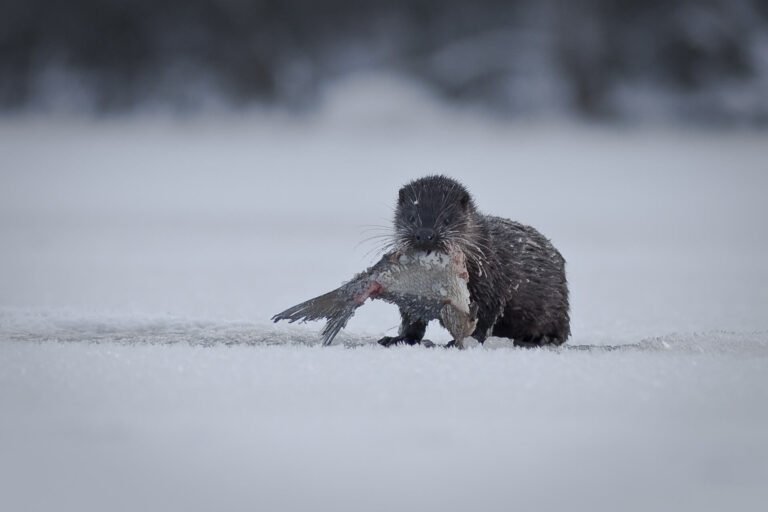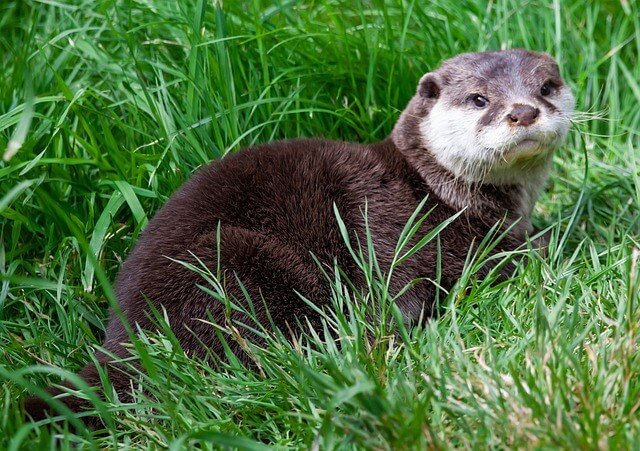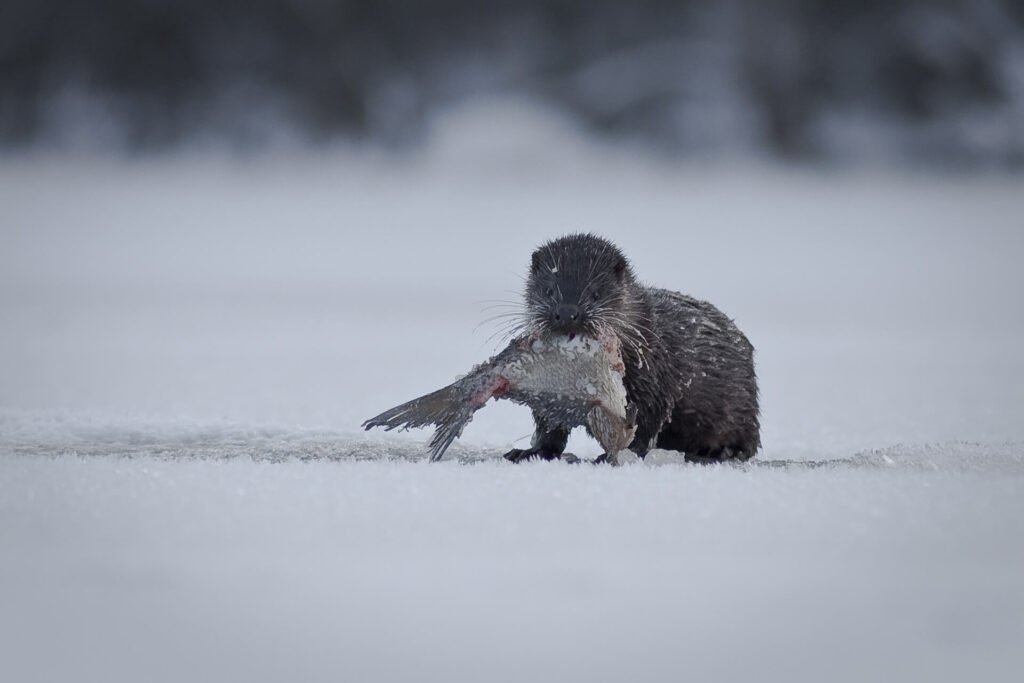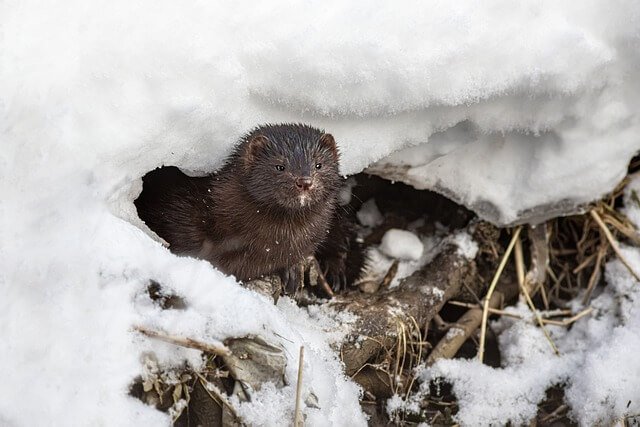Nessi, the famous loch ness monster, may just be an otter.
Seriously, I am not making this up!
It’s assumed that some people saw an otter in the loch ness and, from far away, confused it for the loch ness monster.
Here are even more incredible facts about otters! (And I’m not making these up either.)
Otters are playful!
All of them. Like all mustelids, otters are playful animals and known to do things just for fun, like sliding down hills into the water, playing with stones, and wrestling with other otters.
An Otter Baby Is Called a Puppy Or a Kitten
Otters give birth to one baby every year, and both parents will care for the new puppy. An otter baby will stay for about 2 years with their parents. Often, older siblings help raise younger offspring – which shows us how social these animals really are.
A group of sea otters is called a raft.
A male otter is called a dog or a boar, while females are called bitch or sow.
Otters are truly water acrobats!
… and can be found in or near rivers and seas, where they spent most of their life hunting and playing in the water.
They’re excellent swimmers, thanks to their webbed feet.

Fishermen in Bangladesh use otters to fish in rivers
A practice also used to catch trouts in some parts of Europe in the 17th century.
There are 13 different otter species
And they’re all aquatic, semi-aquatic, or marine animals, meaning they live in and around water. Their natural habitats are rivers, seas, coasts, or ponds. They have a life span of about 16 years, even though most of them don’t grow that old in the wild. They’re all excellent swimmers due to their webbed feet and can hold their breath for up to 5-8 minutes (depending on the species), which is most likely longer than you could hold your breath!
They are part of the Mustelidae family, along with...
Ferrets, Weasels, Stoats, European Polecats, Badgers, Mink, and Wolverines.
The Otter Diet
Otters are carnivores and highly active predators.
Their diet involves fish and invertebrates.
They also hunt frogs, crabs, shellfish, crayfish, and occasionally birds.
The giant otter, who lives in the amazon river, is known to hunt small caimans and anacondas!
Their population is on the decline
Due to overfishing, habitat loss, use of pesticides, and illegal hunting. Many countries, however, protect and support population recovery. The united kingdom, for instance, announced that otters had returned to every county in England. The population increased by 55% within 8 years, most likely due to a ban on pesticides, leading to higher water quality and more prey for otters to catch. That’s good news!
The biggest otter award goes to...
The Giant otter – who can reach a body length of 5.6 ft (1700 cm) and lives in the Amazon River and in the Pantanal. This beautiful creature hunts, like all otters, fish, but is also known to hunt turtles, snakes, and even small caimans. It has no natural predator but humans.

The smallest otter...
Is this Asian small-clawed otter – with a length of 18 to 24 in (47 to 61 cm). The adorable small-clawed otter is quite social, and lives in groups of up to 15 otters. This species is known to scream for help of other otters when in danger. Their natural habitats are rivers, swamps, coastal lagoons, and tidal pools. They can sometimes also be found in irrigated rice fields in India and Southeast Asia.

The heaviest otter is...
The heaviest otter is the sea otter! They’re also the heaviest animal in the Mustelidae family and even heavier than the giant otter, with a weight of up to 99 lb (45kg). The giant otter can weigh up to 71 lb (32 kg).

Another Sea Otter fact
They have the thickest fur of all animals. Which was the reason why humans used to hunt them on a large scale until 1911 – causing a sea otter population decline from (estimated) 150.000 – 300.000 to less than 2000 individuals. The international sea otter hunting ban was the most crucial step and lead to a recovery, but they’re still considered threatened.
They're not only a pretty face
Otters are pretty clever and known to use stones as tools to crack open clams and sea urchins. However, the Asian small-clawed otter prefers to place shellfish in the sun, waiting for the heat to open up the clam. Lazy, but still pretty clever.
The habitat of an otter always involves water. And fish!
Lots of fish. The natural otter habitat involves rivers and lakes, and seas. You can also find them in streams, ponds, and swamps. And on the coast. They can live in both warm and cold water habitats with healthy fish populations.
Otters aren't happy as pets.
Once hunted nearly to extinction for their fur, now to become pets.
Having such a cute face can have fatal consequences for otters in Asia – where they are poached from the wild and sold as pets.
Otters are wild animals who need to actively hunt and swim and can’t be happy, kept in captivity in cages as pets.
Gladly, commercial otter trade isn’t legal in most countries.
Otter vs. Beaver - What's the difference?
They have some similarities. They’re both semiaquatic animals with thick fur and sometimes get confused from a distance. They’re entirely different, though. Otters are carnivores and hunt fish and other small animals. Beavers are rodents, and their diet involves tree bark, aquatic plants, grasses, and sedges.

Otter vs. Mink - What's the difference?
Otters and minks are both carnivores and part of the weasel family, with love for fish.
They have a similar appearance, are both semi-aquatic animals, and have thick fur.
Otters are bigger than minks and have a bigger but flat skull.
You are more likely to see a mink in nature because otters are nocturnal and quite shy.

Otter Wall Art From Our Shop
Add some love to your home with an art print of your favorite animal – the otter! We feature adorable Otter wall art – perfect for decorating your living room, bedroom, bathroom, kids’ room, office, or nursery! Get yours now!
-
 $20.00 – $29.00 inc. VatSelect options This product has multiple variants. The options may be chosen on the product page
$20.00 – $29.00 inc. VatSelect options This product has multiple variants. The options may be chosen on the product page -
 $20.00 – $29.00 inc. VatSelect options This product has multiple variants. The options may be chosen on the product page
$20.00 – $29.00 inc. VatSelect options This product has multiple variants. The options may be chosen on the product page -
 $20.00 – $29.00 inc. VatSelect options This product has multiple variants. The options may be chosen on the product page
$20.00 – $29.00 inc. VatSelect options This product has multiple variants. The options may be chosen on the product page -
 $20.00 – $29.00 inc. VatSelect options This product has multiple variants. The options may be chosen on the product page
$20.00 – $29.00 inc. VatSelect options This product has multiple variants. The options may be chosen on the product page